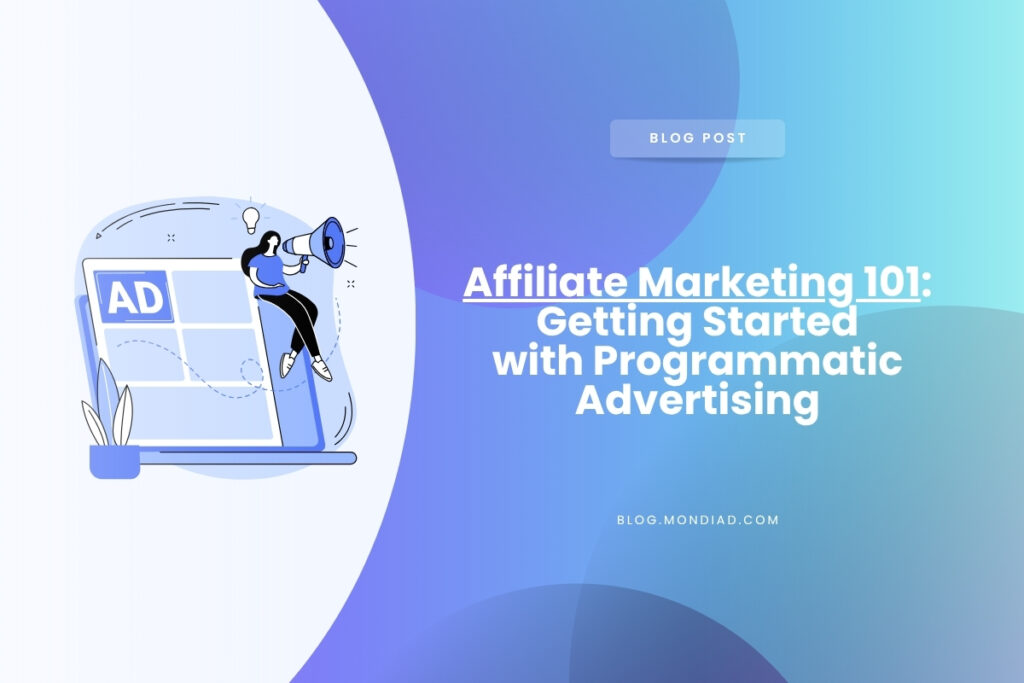Believe it or not, affiliate marketing has grown from a niche practice to a multi-billion-dollar industry. However, take everything with a grain of salt… it’s very unlikely you’ll get rich overnight.

The important message is tough… it’s a very lucrative business model, however you have to get the gist of it. Do you have what it takes to join this club? Keep reading and you’ll be closer to finding out.
The history of affiliate marketing
Affiliate marketing began in the mid-1990s, with Amazon’s Associates Program pioneering the model of earning commissions through referrals.
The 2000s saw rapid growth driven by e-commerce platforms and affiliate networks like CJ Affiliate, along with the use of SEO and blogging for organic traffic.
Social media platforms in the 2010s enabled influencers to become major players in affiliate marketing, while tracking technologies improved transparency.
By the late 2010s, mobile marketing, programmatic advertising, and diverse niches such as SaaS and subscriptions reshaped the industry.
Nowadays, AI, automation, interactive content, and global outreach define the modern affiliate marketing landscape, ensuring its continued evolution.
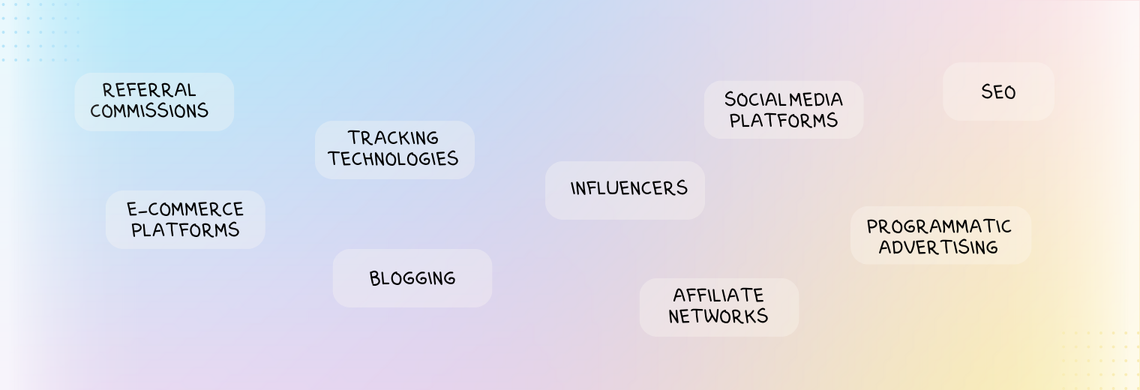
- you want a long-term passive income. High-quality, evergreen content can continue earning commissions for years.
- you want full control over your work, working from anywhere, on your own schedule, and choosing models that vibe with your interests and expertise.
- you are a creative yet also analytic soul. Creativity will make you stand out from the competition while your analytic skills will help you identify winning patterns in an ever dynamic market.
- you want to keep it simple. Starting affiliate marketing requires minimal upfront investment compared to other business models. Plus, you don’t need to create or stock products; you only promote them.
What is affiliate marketing?
Much like its name implies, affiliate marketing is a type of digital marketing in which one person(the affiliate) earns commissions for any sale he generates by promoting another company’s products or services.
Affiliate marketing can be a highly effective marketing strategy for businesses of all sizes, allowing them to increase brand awareness as well as generate leads and sales with minimal upfront costs. By outsourcing their marketing efforts, they are reducing their marketing costs by paying only for the actual results while affiliates earn commissions.
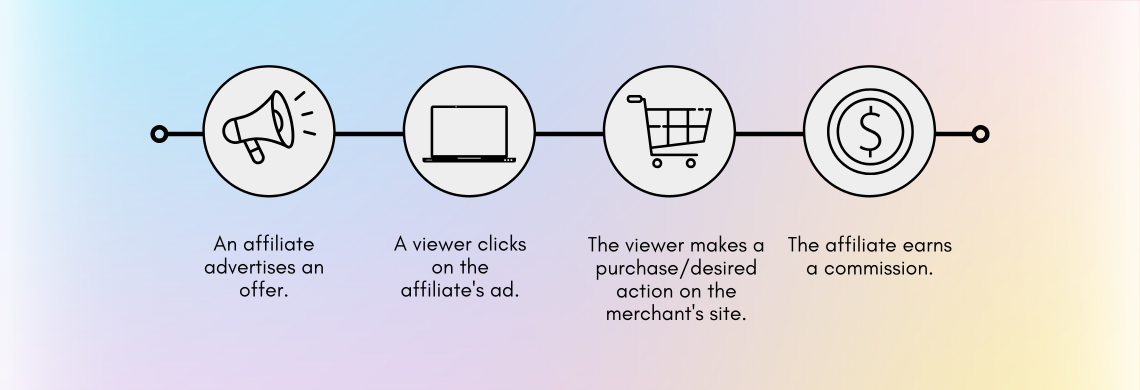
You can think of affiliate marketing as a win-win partnership.
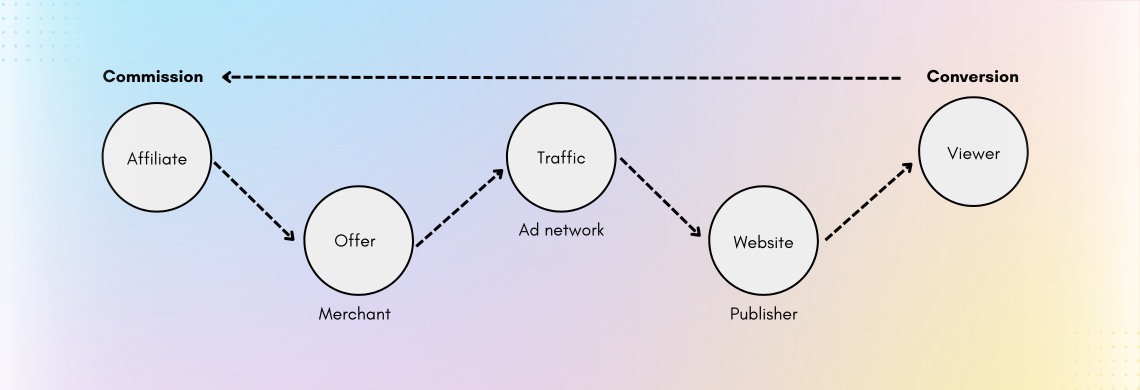
|
Merchant |
The company or individual that wants to sell a product or service.
These networks usually provide an affiliate manager, namely an individual responsible for managing an affiliate program who provides support for the affiliate, and ensures affiliates adhere to the program’s terms and conditions. |
|
Affiliate marketer |
The affiliate marketer earns a commission on any resulting sales or leads that are generated through their promotion of the advertiser’s products or services. |
|
Ad network |
This is us. We connect advertisers with publishers. In the context of affiliate marketing, the affiliate becomes an advertiser by buying traffic from our network to promote affiliate offers via ads, for commissions. |
|
Ad Tracker |
An ad tracker is a tool or software used to monitor, analyze, and optimize the performance of advertising campaigns, especially used in affiliate marketing. By understanding which ads and traffic sources are most effective, marketers can optimize their campaigns for better performance. |
|
Customer |
The end user who views the affiliate’s ad, clicks on it and makes a purchase or completes a desired action on the advertiser’s site. The customer’s actions are tracked and attributed to the affiliate, leading to the commission payment. |
Types of affiliate marketing:
| Affiliate marketing type | Examples | Best suited for |
| Content-Based Affiliate Marketing This is one of the most popular forms of affiliate marketing. Affiliates create high-quality, value-driven content to attract and engage audiences. |
Blog posts, reviews, tutorials, comparison articles, and videos. | Bloggers, YouTubers, and content creators with niche expertise. |
| Social Media Affiliate Marketing Affiliates leverage social media platforms to promote products and share affiliate links. |
Instagram posts, TikTok videos, Facebook groups, or Twitter threads. | Influencers and individuals with a strong social media following. |
| Email Affiliate Marketing Affiliates build an email list and promote affiliate products directly to their subscribers. |
Newsletters, exclusive offers, and personalized product recommendations. | Affiliates with established mailing lists and strong email marketing skills |
| PPC (Pay-Per-Click) Affiliate Marketing Affiliates invest in paid advertising to drive traffic to their affiliate links. |
Google Ads, Bing Ads, Mondiad  or social media ad campaigns. or social media ad campaigns. |
Experienced marketers comfortable with paid traffic strategies and ROI calculations. |
| Influencer Affiliate Marketing This is a type of affiliate marketing where influencers leverage their credibility to recommend products to their audience. |
Instagram stories, YouTube sponsorships, or TikTok product placements. | Influencers with a loyal and engaged audience. |
Whether you’re creating engaging content, leveraging social media, or diving into paid ads, there’s an affiliate marketing model for you to explore. But since digital advertising is our cup of tea, moving forward we will dive deeper into this affiliate model.
Dipping the toes in affiliate waters
🔸 Choosing a niche
In the context of advertising and affiliate marketing, a “vertical” refers to a specific industry or niche that advertisers or affiliate marketers target with their campaigns. Simply put, it represents a category of products or services that share common characteristics or interests among its audience.
| E-commerce | Endorsing and recommending various products and services available through online retail platforms. |
| Nutra | Offers promoting health and beauty: selling beauty products, anti-ageing creams, weight loss products, men’s potency enhancements, Vitamins and dietary supplements, products to improve concentration and performance, teeth whitening pastes, health insurance plans, and all even good health/luck charms. |
| Sweepstakes | A promotional contest or giveaway where participants can win prizes based on luck, rather than skill, usually in exchange for a piece of information like their email address. The usual prizes showcasted may include cash, vacations, gift cards, electronics, or any other items of value. |
| Betting | Offers designed to attract players to casinos and betting platforms. They promote various incentives like welcome bonuses, free spins, exclusive games, cashback deals, loyalty programs and so on. |
| Finance/Crypto | Offers endorsing financial services, tools, and products related to the financial sector and the cryptocurrency market. |
| App utilities | Offers promoting various mobile and desktop applications that provide useful functionalities to users: productivity tools, security apps, VPN, etc. |
| Dating | Offers designed to attract individuals to join dating platforms, sign up for memberships, or engage in specific dating-related activities. |
| Adult | Offers eadvertising various products, services, and content that fall under the adult entertainment industry: adult toys, subscription-based content, etc. |
Choosing the right niche is one of the most critical decisions when starting as an affiliate marketer. The niche you select will influence every aspect of your affiliate business, from your marketing strategy, audience targeting, to your monetization potential and long-term profitability.
A niche you’re passionate about or knowledgeable in makes will make the process enjoyable, boosting creativity and resilience through challenges.
Establishing authority in your niche is vital for credibility. A carefully chosen niche enables you to build a reputation as a trusted resource, which is essential for audience trust and higher conversion rates. This trust translates into higher click-through and conversion rates for your affiliate links.
Research market demand
Some niches, like health and wellness, are saturated but profitable, requiring a solid USP (unique selling proposition) to succeed. Others, such as eco-friendly products, may have moderate competition but require educating audiences. Your ability to identify a niche where you can offer unique value will directly impact your ROI.
Use tools like Google Trends, SEMrush, or Ahrefs to gauge the search volume and interest in your potential niche. Look for niches with steady or growing demand. Seasonal niches (e.g., Halloween decorations or winter apparel) can also be lucrative but require timing and strategy.
Think long-term
Focus on niches that aren’t overly dependent on trends to ensure scalability. A niche with consistent demand (e.g., personal finance, beauty, parenting) ensures longevity in your affiliate marketing business. Choosing a fad or overly seasonal niche might generate short-term results but isn’t sustainable over time.
Assess restrictions
Verify if your chosen niche has restrictions when it comes to advertising it in said platforms or locations. (e.g., gambling, adult content, certain health claims).
Evaluate competition
Investigate how competitive the niche is. Too much competition may make it hard to break through, but a lack of competition could signal low demand.
As you see, the niche you choose sets the foundation for your entire affiliate marketing journey. Take your time when evaluating this step since it’s an investment in your success.
🔸 Finding your affiliate squad
How to identify relevant offers?
Naturally, the offer you choose should align with your niche and cater to your target audience’s needs. For example, if you’re in the fitness niche, promoting a workout app or health supplement is logical; promoting software wouldn’t resonate.
Evaluate commission structures
Affiliate marketing encompasses several models that affiliates and merchants can choose from based on their goals and the nature of their partnership.

The primary types of affiliate marketing models include:
|
MODEL |
HOW IT WORKS |
EXAMPLE |
|
Pay-Per-Sale (PPS)
|
In the Pay-Per-Sale model, affiliates earn a commission for each sale generated through their links. When a customer clicks on the affiliate’s link and makes a purchase on the merchant’s website, the affiliate earns a percentage of the sale value as a commission. |
An affiliate promoting a fitness product earns 10% of the sale price for each product sold through their unique link. |
|
Pay-Per-Click (PPC)
|
In the Pay-Per-Click model, affiliates earn money each time a customer clicks on their link, regardless of whether the customer makes a purchase. The affiliate’s earnings are based on the number of clicks their links receive. This model focuses on driving traffic to the merchant’s website. |
An affiliate promoting an online clothing store earns $0.05 for every click on their banner ad, regardless of whether the visitor buys anything. |
|
Pay-Per-Lead (PPL)
|
In the Pay-Per-Lead model, affiliates earn a commission when a customer completes a desired action, such as signing up for a newsletter, filling out a contact form, or registering for a free trial The merchant specifies the desired action, and the affiliate earns a commission each time a referred customer completes this action. |
An affiliate promoting a software service earns $10 for every user who signs up for a free trial through their referral link. |
High-ticket vs Low-ticket offers
If you have expertise, access to niche audiences, and the ability to build trust, high-ticket offers can provide greater ROI. If you’re focusing on mass appeal, have access to large traffic sources, and want consistent cash flow, lower-ticket, high-volume offers may be a better fit.
| High-Ticket Offers | Low-Ticket Offers | |
| Price Point | High | Low |
| Target Audience | Niche audience seeking premium or exclusive solutions. | Broad audience interested in affordability. |
| Conversion Cycle | Longer sales cycle, requires more trust-building. | Short sales cycle, often impulse purchases. |
| Commission | High per sale, (e.g., $100-$500+). | Low per sale, (e.g., $1-$10). |
| Traffic Needs | Lower volume, high quality | High volume |
| Effort Required | High effort per sale (personalization, education). | Lower effort but requires scaling. |
| Advantages | Significant revenue from fewer conversions. | Easier to convert; consistent cash flow. |
Check Advertiser Reputation
Research the advertiser’s reliability, payment terms, and brand perception. Poor reputation can hurt your credibility as an affiliate.
Look for Support and Resources
The best programs provide affiliates with tools like banners, landing pages, and detailed tracking capabilities. Ideally, an assigned affiliate manager can also guide you in optimizing your campaigns.
Competitor Analysis
Use tools like AdSpy, SimilarWeb, or simply browse competitors’ websites and social media ads to see what offers they are promoting.
💡 Diversify Offer Sources: Avoid relying on a single network or program. Having multiple streams of offers can protect your income and give you more options to adapt to market changes.
🔸 Setting up a funnel
Any plan starts with a goal. A good plan at least.
Define your goals
Set clear objectives like want to achieve, such as generating leads, driving conversions, or increasing sales. Make sure your goals are clear and measurable. To be able to asses the performance of your efforts, you will also need to choose a set of metrics that will define your success, (e.g. click-through rate (CTR), conversion rate (CVR), return on ad spend (ROAS), or cost per acquisition (CPA).
Understand your audience
Identify the pain points, needs, and preferences of your target demographic. Analyze what you are promoting, what is the value proposition and what problem it solves. Consider demographics and psychographics like age, gender, income, lifestyle, education level, behaviour, etc. Study Competitor Strategies to see who they target and how they attract customers.
You can definitely think of more ways to gather data on your ideal customer, however the goal is, after gathering as much data as you can, to design a well-detailed audience persona, representing your ideal customer.
Example Persona
Name: Fitness Fiona
Age: 25-35
Interests: Yoga, clean eating, fitness tech
Behavior: Responds well to discounts and influencer endorsements
Design a funnel
A funnel acts like an action plan which will help you easily visualize your strategy, track your efforts, and help you identify optimisations that can be made.
- Awareness Stage: Attract the audience
- Consideration Stage: Engage prospects
- Conversion Stage: Drive action
🔸 Setting up an advertising strategy
In digital advertising, targeting the right audience, designing the right ad creatives, optimizing traffic performance, and getting the most out of your budget are all parts of your success.
Choose your ad formats:
There is a plethora of advertising formats out there, each with its own pros and cons.
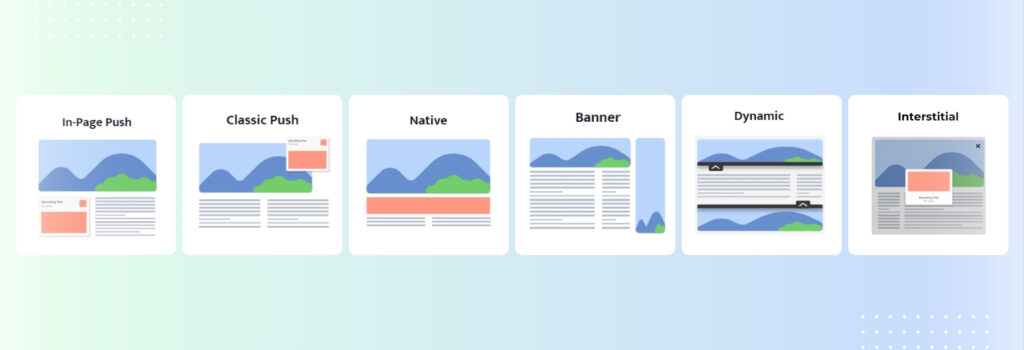
Here a are a few popular types.
| Push notifications | The classic push appear as a notification on a device screen, laptop or mobile. The In-page push appears similarly, but as a notification or message within a browser. |
| Native | Native ads blend seamlessly into the surrounding content and appear as if they are part of the website. |
| Banner | Banners are visual magnets of many sizes/shapes, placed strategically to boost conversions. |
| Dynamic | A dynamic ad is an ad format that slides into view within the header or footer of a webpage as the user scrolls down through it. Once triggered, the ad remains stationary in the header/footer until the viewer chooses to close it. |
| Interstitial | Interstitial ads are full-screen ads that appear during natural transition points within a website(or mobile app) such as when a user finishes reading an article, completes a level in a game, or navigates between sections within an app. |
| Pops | Pop-up ads appear in a new browser window or tab that opens above the current web page. Popunders open in a new browser window or tab but appear behind the current window, so they are seen only after the user closes or minimizes the main browser window. |
Create compelling ad content:
Continuously test different ad variations to identify what works best. Test headlines, images, CTAs, and even different ad formats. In Mondiad you can create a maximum of 10 creatives in one ad campaign.
Use spy tools as an extra layer of inspiration for creatives that work in your niche of choice.
Traffic and budget:
Essentially, the more you spend (your ad budget), the more traffic you can potentially buy and the more impressions, clicks, or conversions you can achieve. However, how you allocate and manage that budget will significantly impact the results.
Higher Budget = More Traffic, Low Budget = Limited Traffic
But money isn’t everything, it’s also about how you manage it. You can control how your budget is spent over a specific time period. For example, if you have a daily budget, you may need to pace your bids to ensure consistent traffic delivery. A higher budget might allow more aggressive pacing, while a lower budget could limit your campaign’s reach, especially if bidding competition is high.
Your success will also depend on the countries that you are targeting. Tier 1 countries are highly developed markets with strong consumer purchasing power. Tier 2 countries are typically emerging or developing markets, while Tier 3 countries represent less developed markets.
💡 We advise launching a campaign with a broad targeting for about a week, then, when data is gathered, you can granularly eliminate underperforming segments. Additionally, use as many tools and features available to gather and optimize your data. Ad trackers, automation rules, traffic audiences, Whitelists, Blacklists and so on.
Best affiliate marketing practices

🔸 Stay updated on market dynamics
Keeping pace with changing market dynamics is essential for staying competitive and making informed decisions about your efforts.
Trends to watch:
- AI and Machine Learning in Ad Optimization: AI tools are popular since they automate bidding, segment audiences, and refine ad creatives based on real-time performance.
- Augmented reality and gamilification are still top dogs when it comes to engaging users.
- Sustainability remains a theme many stick to. Consumers are increasingly drawn to brands that demonstrate environmental and social responsibility.
🔸 Network with like-minded peers
Find experienced marketers who can provide guidance and encouragement. Talking about your experiences with others can offer fresh perspectives and emotional support.
- Subscribe to reputable blogs and newsletters, to stay informed about market trends and updates.
- Attend conferences, webinars, and online communities to exchange insights and learn from peers. If you do, let’s meet!
- Join industry forums and discuss with fellow affiliates about whatnot.
🔸 Stay consistent, be patient and organized
- Affiliate marketing is not a “get-rich-quick” scheme. At least not to the majority.
- Don’t be afraid to make mistakes. Actually, this is what it’s all about. Your failures are not setbacks but learning opportunities. If a campaign fails, assess why and adjust your strategy.
- Celebrate small wins to keep up your vibes. Acknowledge every step forward, like getting your first sale, increasing traffic, or improving conversion rates.
- Set realistic workloads and take breaks to maintain focus and motivation over the long term.
- Focus on your journey, not others’ successes, as everyone’s path is different.
Don’t leave money on the table. Every successful marketer was once where you are now! Start here.
